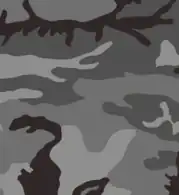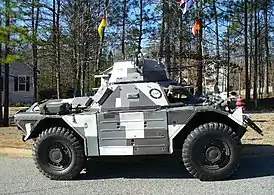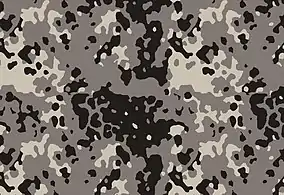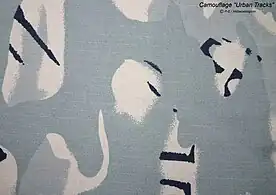.jpg.webp)
Urban camouflage is the use of camouflage patterns chosen to make soldiers and equipment harder to see in built-up areas, places such as cities and industrial parks, during urban warfare.[1][2]
Several armed forces have developed urban camouflage patterns. Some are in use with paramilitary forces.
History
Urban camouflage has rarely been used by armed forces in built up environments and mostly for limited trials. During the Cold War, the British Army used vehicles painted in the "Berlin camouflage" urban pattern.[3] The scheme was developed by Major Clendon Daukes of the 4th/7th Royal Dragoon Guards.[4]
Techniques of developing urban camouflage have varied across time. In 1990, the US Army's Natick Research, Development and Engineering Center (now the Combat Capabilities Development Command Soldier Center) analyzed individual samples of terrain ranging from rubble piles to stucco through the Terrain Analysis System (TAS). From these samples, the TAS gathered spectrophotometric data in order to determine the most prominent colours. This was known as the "clustering" procedure, where pixels of the scene were grouped by colour into "domains". These domains provided data that demonstrated the range of colours in the scene through mean colour difference and CIELAB values. The results provided by the TAS were used to assist in the development of candidate urban camouflage patterns.[5]
The US Army developed and evaluated two two-colour and one three-colour prototype patterns for a projected Military Operations on Urbanized Terrain (MOUT) camouflage uniform in 1994. The patterns showed promise but were never adopted.[6]
Gallery
 Prototype urban variant of US Woodland pattern
Prototype urban variant of US Woodland pattern A Ferret Scout Car in "Berlin camouflage"
A Ferret Scout Car in "Berlin camouflage" Prototype M84 urban variant
Prototype M84 urban variant US Marine Corps MOUT T-pattern or T-block prototype, 1990s
US Marine Corps MOUT T-pattern or T-block prototype, 1990s Natick's "Urban tracks" prototype
Natick's "Urban tracks" prototype
References
- ↑ Steck, Thomas T. (October 1980). Camouflage and Deception Techniques for Urban Warfare (PDF). US Army. pp. 18 and whole document. Archived (PDF) from the original on July 26, 2021.
2. Urban Camouflage Patterns. This project would develop various camouflage patterns for use in urban areas. Patterns would include harsh and soft geometric patterns as well as soft, random curves utilized in the current Army field camouflage patterns.
- ↑ Reimer, Dennis J. (12 May 1993). An Infantryman's Guide to Combat in Built-up Areas (PDF). US Army. pp. 5.40–5.44.
Standard camouflage pattern painting of equipment is not as effective inbuilt-up areas as a solid, dull, dark color hidden in shadows. Since repaintingvehicles before entering a built-up area is not always practical, the lightersand-colored patterns should be subdued with mud or dirt.
- ↑ Davies, W. (2012). "Berlin Brigade Urban Paint Scheme". Newsletter. Ex-Military Land Rover Association. Archived from the original on 12 March 2013. Retrieved 25 September 2012.
- ↑ Chris Copson (17 November 2023). Can you make a tank disappear? The Evolution of Tank Camouflage. The Tank Museum. Event occurs at 14:47-15:52. Retrieved 17 November 2023.
- ↑ Hepfinger, L. B. (February 1990), Analysis of Urban Terrain Data for Use in the Development of an Urban Camouflage Pattern, US Army. Whole document.
- ↑ "Urban Camouflage". Department of Defense. Retrieved 23 January 2021.
.jpg.webp)